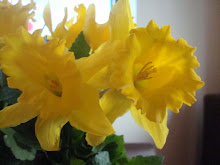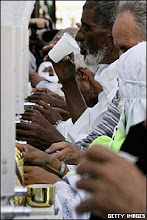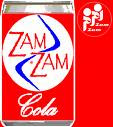I can not put this book down!
The Autobiography of Malcolm X is an amazing insight from the street life in Harlem all the way to the royal palaces of Saudi Arabia. It contains the words of one of the most important transformations that American Muslims could ever look up to. The humor

, the sincerity, the beautiful heart that Malcolm X so bravely put forth in the search for truth. And the truth is, I haven't read the last 20 pages because they contain the sad truth of his end. I don't want to know how many times he got shot by the cowardice of men. His strength I can feel emanate from his words. He had a way with words.
His pilgrimage to Mecca really shows his complete submission to Allah. His observations are near to my heart: (Pg 346) "Never have I witnessed such sincere hospitality and the overwhelming spirit of true brotherhood as is practiced by people of all colors and races here in this Ancient Holy Land, the home of Abraham, Muhammad, and all the other prophets of the Holy Scriptures. For the past week, I have been utterly speechless and spellbound by the graciousness I see displayed all around me by people
of all colors. "I have been blessed to visit the Holy City of Mecca. I have made my se

ven circuits around the Ka'ba, led by a young
Mutawaf named Muhammad. I drank water from the well of Zem Zem. I ran seven times back and forth between the hills of Mt. Al-Safa and Al-Marwa. I have prayed in the ancient city of Mina, and I have prayed on Mt. Arafat.
"There were tens of thousands of pilgrims, from all over the world. They were of all colors, from blue-eyed blonds, to black-skinned Africans. But we were all participating in the same ritual, displaying a spirit of unity and brotherhood that my experiences in America had led me to believe never could exist between the white and the non-white."
---
The entire chapter on Mecca starting on page 325 simply enchants me because of his real life experiences with this religion.
This particular entry brings up a couple of points that I'd like to mention that have to do with the study of Anthropology:
- Anthropology of Religion--involves the study of religious institutions in relation to other social institutions, and the comparison of religious beliefs and practices across cultures...In the early 11th century, Abu Rayhan Biruni (973-1048), wrote detailed comparative studies on the anthropology of religions and cultures across the Middle East and Mediterranean and especially the Indian subcontinent. Biruni's anthropology of religion was only possible for a scholar deeply immersed in the lore of other nations. He carried out extensive, personal investigations of the peoples, customs, and religions of the Indian subcontinent, and was a pioneer in comparitive religion and the anthropology of religion. (Wikipedia: Anthropology of religion)
- Experimental Archaeology(Anthropology)/Applied Anthropology-- I spoke with Ifrah Atiqi, a UH alumni about her outlook on Anthropology, what her favorite sub-field was, and just some general advise via G-chat :)Ifrah: you want to major in anth?
me:yeah
InshAllah (God-willing)
Ifrah: thats good
its really interesting
9:37 PM but unless you pursue a masters, it may not pay off career wise
me: Yeah, I've heard that. Mostly to teach
is that what you are doing with your masters?
9:38 PM Ifrah: i'm actually going for international business
9:40 PM me: oh cool. So you were you able to focus on linguistics during your undergrad?
9:43 PM Ifrah: i wasnt
but that was my favorite
UH doesnt have the best anth dept
but they are getting bigger
i graduated over a year ago
and towards the end of my 4 years they were expanding
9:44 PM me: oh ok, cool well that's good to know
9:58 PM Ifrah: i like religion and anthropology a lot
its easy to relate on it
me: like what?
Ifrah: just rituals
9:59 PM like hajj
we like to enact what happened in abrahams time
its interesting
me: what can anthropology do to study hajj?
10:00 PM oh
Ifrah: random things about it
like zam zam water
10:01 PM we feel it heals our sickness
etc etc
- The issue of race in Cultural Anthropology which in this case would be an enthnography from Malcolm X's book. "America needs to understand Islam, because this is the one religion that erases from its society the race problem... I could see from this, that perhaps if white Americans could accept the Oneness of God, then perhaps, too, they could accept in reality the Oneness of Man-and cease to measure, and hinder, and harm others in terms of their 'differences' in color... Despite my firm convictions, I have been always a man who tries to face facts, and to accept the reality of life as new experience and new knowledge unfolds it. I have always kept an open mind, which is necessary to the flexibility that must go hand in hand with every form of intelligent search for truth.
 Zamzam Studies and Research Centre
Zamzam Studies and Research Centre






